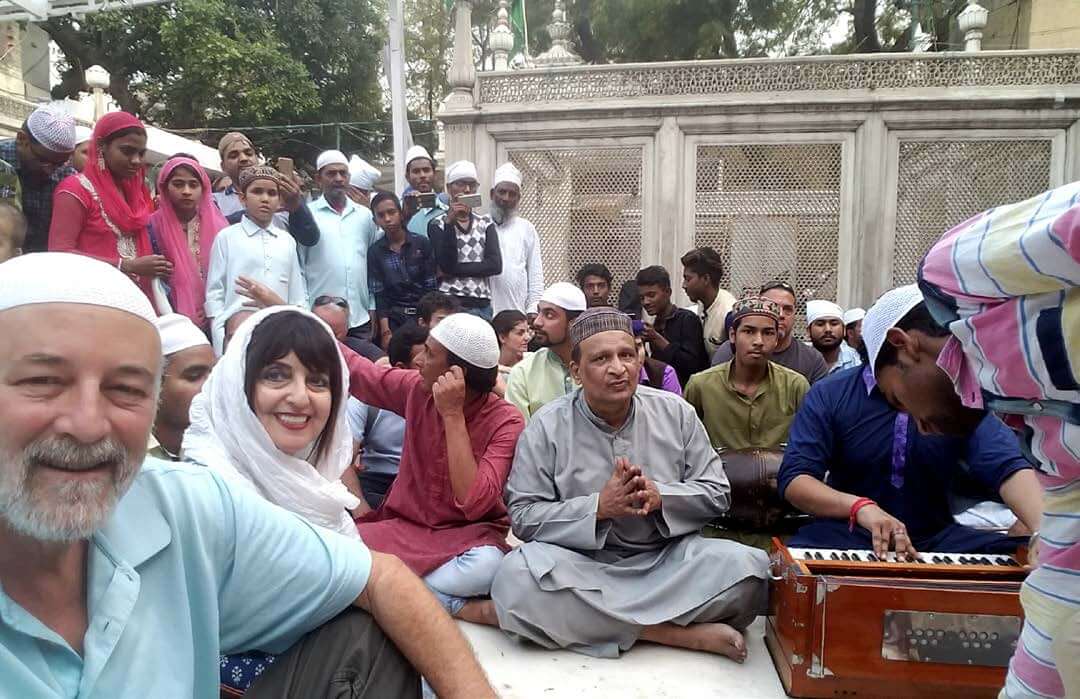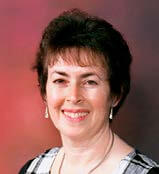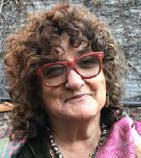Above: Ken Goldman. Jacob’s Ladder Triptych, 2015. Chromaluxe print after performance. Photos by Gideon Cohen
THE PROFESSION: ROUNDTABLE
Introduction
Jason Schulman: For Jewish Studies scholars, especially those who study global Jewry (past and present), travel to foreign lands is a vital part of the scholarly endeavor. Such professional travel, like academic research in general, is objective and dispassionate. Unlike, say, personal or family trips, which are emotional and even spiritual.
Or so we might think.
In fact, for scholars of Jewish Studies, the line between academic and personal is so thin as to all but disappear. In this roundtable, four scholars reflect on their Fulbright journeys, and how Jewishness—as a research subject, and as a personal identity—mattered in their travel.
For some, the initial Fulbright trip had nothing to do with Jewishness, but in due time, it became a key research area, while for others the Fulbright journey was the culmination of a search for Jewishness.
A commonality among all these scholars—who traveled as part of the prestigious travel abroad program founded in 1946 and named for Senator J. William Fulbright of Arkansas—was the opportunity to encounter the variety of global Jewish life. The reality of these Jews in these “exotic” locales upends our usual, mostly American, perception of Jewishness, especially its Ashkenormativity. Moreover, these scholars’ travel to places where there used to be large (or at least, larger) Jewish populations offers a bridge between the present and the past (and in some cases, even a bridge to the future).
What is clear from these scholars’ journeys—and why we tell students to study abroad—is that travel is immersive: travelers encounter local Jewish communities (and other religious communities) and engage in their language, food, prayer services, and holiday celebrations. By taking us out of our comfort zone and into unknown land—that feels, as one scholar puts it, “uncannily familiar”—travel, which blends the academic and the personal for Jewish Studies scholars, really is a spiritual endeavor, taking us out of the everyday and into the transcendent.
Jewish Travel to Bosnia and Herzegovina
Francine Friedman: Jewish travelers may find that their religion does not affect their travel. This unexpectedly turned out not to be the case when I traveled to southeastern Europe in 1997 after the Bosnian War. I had been invited to present research about the Bosnian Muslims from my book, The Bosnian Muslims: Denial of a Nation (1996), and frankly had no plan of engaging in research about the Bosnian Jewish community. However, I paid a courtesy call at the Jewish Community Center and Synagogue and found a surprisingly vibrant Jewish community, given the fact that the horrific siege of Sarajevo had ended only a few years earlier and that the community’s numbers were, as a result of the war, sadly depleted. Becoming intrigued by many stories of wartime Bosnian Jewish activism on behalf of their beleaguered Muslim, Serbian, and Croatian neighbors, I began what became a multidecade search for information about the community, which eventually included a Fulbright year of study in 2012–2013. This research ultimately led me to travel to Israel for a decade of winter breaks, as well as to Serbia to consult Jewish archives. It became obvious to me that my research about the Bosnian Jewish community could not be confined to one locale. I had to travel in order to more fully comprehend the historical, cultural, and socioeconomic contributions that Bosnian Jews had made to their milieu, because elements of their story resided in many locations.
I did not originally travel to Bosnia and Herzegovina as a Jew for Jewish reasons, but I ended up returning for many summers to immerse myself in a Jewish experience. Being born into an Ashkenazic family, I had little knowledge about Sephardic practices.
It took me only a few years to become familiar with the Sephardi-dominated community, their food, their customs, and their ways of perceiving the world. This knowledge informed my research and broadened my perspective of the Jewish world. The Bosnian
Jewish community generously welcomed me and
enthusiastically assisted me in my research.
I believe that I can safely attest that my presence in the Sarajevo Jewish community for so many years had an impact on the Bosnian Jewish community. Their acceptance, even celebration, of my presence as an Ashkenazic American who showed interest in a largely Sephardic community might have served as a bridge between the Jewish communities. Sharing incidents from daily life with each other underlined the fact that people (Jews particularly?) have much in common that dividing oceans cannot erase. Indeed, the Bosnian Jewish community might have come to a new understanding of, and sympathy for, American Jews, given that one was willing to immerse herself in their communal celebrations, as well as their concerns. I know that my understanding and appreciation of this “exotic” Jewish community became a highlight of my professional and personal life.
Searching for Sefarad
Nancy Saporta Sternbach: From my earliest travel to Spain as a teenager, I now understand, I was searching for Sefarad, though I did not yet possess this vocabulary. Instead, I followed my dream of becoming a fluent speaker of Spanish, the word we used for the language my ancestors had brought with them from Spain, via four hundred years in Turkey. It would not be until much later that I even heard the word “Ladino.” Making a career as a Spanish professor and exploring the Spanish-speaking world became my passion, with my Sephardic heritage always embedded in these journeys.

The classic song in Ladino, ‘Adio, Kerida,’ sung here by a group in Plovdiv, Bulgaria on Israel Day at the Jewish Community Center. Courtesy of Nancy Saporta Sternbach
Then, in 2014, I received a Fulbright grant to Istanbul for a Sephardic project. A few years earlier, my Sefarad-leaning inclinations had taken me to my grandparents’ town in southwestern Turkey, Bergama, where I was privileged to hear their dear and familiar accent spoken by one the town’s last Jews—a relative, it turns out. That did it: Turkey became my passion. I had to discover everything about it and uncover our family history, a history whose few documents either burned in the epic fires of the early twentieth century or were written in languages I never would speak.
“You got a Fulbright to write a cookbook?” friends and colleagues asked in amazement. Yet, what better vehicle to study a culture than through its cuisine, in its local context, adjusted to cultural and religious norms? I had grown up with a love for the Sephardic culinary tradition channeled into the persona of my grandmother, Nellie Corkidi Saporta. Once in Istanbul, unlike my native New York, I found the Sephardi-Ashkenazi divide reversed. Here, “Jewish” meant Sephardic. Suddenly I was not a strange minority. Suddenly the customs that were so “exotic” in New York were familiar to me.
I visited Jewish nursing homes where the lingua franca was Ladino. There, ancient women confined to wheelchairs with gnarled arthritic fingers folded paper napkins into pastries as they explained to me in Ladino how to shape a borekita, a bulema, a boyo. I entered Jewish cultural centers and visited “Jewish sites”: ancient synagogues, some in states of such disrepair as to break your heart. I dubbed myself a “heritage tourist,” delving into whatever leads I could find, first in Istanbul and then further afield. In the cemeteries of Istanbul and Izmir and the Jewish Museum of Salonica, I found my maternal family name, Saporta, perhaps my own ancestors, survivors or victims of many migrations, or Nazi exterminations. The Ladino inscriptions on the tombstones at these cemeteries were legible to anyone who spoke Spanish.
Emboldened by the vastness of these discoveries, I traveled to Central Asia, where I visited the Mountain Jews of Azerbaijan, the Jews of Bukhara, Uzbekistan, the Iraqi Jews of Bombay, and the Jews of Georgia and India. My childhood feeling of being excluded from or misunderstood by the Ashkenazim of suburban New York dissolved as I stepped into the synagogue of Bukhara or the Jewish cultural center of Kutaisi, welcomed as a fellow Jew. Born into a dark-skinned, “Spanish-speaking” family, these discoveries helped me to see Jewish history in its richly diverse context, whether in Asia or Latin America. I was part of a global family vaster than Sephardim and Ashkenazim. Some of these had been thriving communities, even if there were only a handful of people left who called them home.
Meanwhile, during all this time, I returned with regularity to Spain, where since 2015, I was now eligible to become a citizen as a descendant of my exiled Sephardic ancestors. Its uniform Catholicism notwithstanding, Spain began to uncover Jewish sites everywhere Jews had lived all over the peninsula. As a result of the law of return, Jews, conversos, and formerly crypto-Jews from everywhere were beginning to repopulate Spanish cities. In August 2021, one hundred years after and perhaps a mile away from the location where my grandmother Nellie first set foot into the United States, I collected my newly minted Spanish passport. My search for Sefarad had led me to understand that rather than just a geography, Sefarad was also a place within myself where I could cherish and reclaim my heritage and ancestors.
My Spiritual Encounters in India
Yudit Kornberg Greenberg: I first visited India in 1993, after a colleague who was teaching our department’s course on Asian religions took an unexpected leave and requested that I take over teaching it. As I reacquainted myself with classics such as the Upanishads and the Bhagavad Gita, I prepared for my imminent visit to India. Since my first journey to India in May 1993, I have taken numerous trips, led field study courses, and have engaged in interreligious and comparative study of Judaism and Hinduism. During my first Fulbright-Nehru Award in 2015, I was based in Delhi, where our Sikh friends lived only a couple of miles from our apartment. This meant experiencing the comfort of family, sharing our daily adventures, and enjoying delicious homemade meals at least three to four times a week. One of the highlights of that five-month stay was our visit with our Indian family to the spectacular Golden Temple in Amritsar, the holy site in Sikhism. Accompanying our friends on this pilgrimage and beholding their joy and gratitude amplified my own sense of awe of the exquisite gold structure surrounded by a lake, and the thousands of devotees who respectfully waited to see the holy text of the Guru Granth Sahib in the inner sanctum of the temple as the echoes of the mantras and the wafting sandalwood incense enveloped us. The culmination of this visit was savoring the langar—the emblematic gesture of Sikh hospitality embodied in the delicious vegetarian meal served to us and thousands of others in the adjacent hall.

Yudit Kornberg Greenberg observing Sufi chanting at Dargah of Hazrat Nizamuddin, Delhi, India, March 23, 2017. Courtesy of Yudit Kornberg Greenberg”
During my 2019 Fulbright-Nehru award, I was affiliated with the University of Mumbai, where I taught a graduate course on religion and gender. In Mumbai, we chose to live walking distance from the Baghdadi synagogue, Knesset Eliyahoo, established by the well-known Sassoon family in 1884, and frequented today mostly by the Bene Israel community and Western visitors. A highlight of our interactions with Bene Israel was being invited to a “Malida” ceremony celebrating a recent marriage. This ceremony is reminiscent of a Hindu puja, consisting of a food offering to the prophet Elijah accompanied by Hebrew recitations. During that semester, I had several opportunities to travel for lectures within the subcontinent and as far as Uzbekistan. A memorable experience was a lecture I gave at a University in Bhubaneswar in the State of Odisha, also known as Orissa, on the topic of my research project, in which I compared notions and metaphors of love and desire in the biblical Song of Songs and the twelfth-century Sanskrit poem, the Gita Govinda. Following the lecture, I visited the town of Puri, about forty miles south, where the Jagannath Temple, an important Vaishnava Hindu site, stands, and where the Gita Govinda is still sung daily. Not able to enter the temple as I am not a Hindu, I still enjoyed celebrating the rich legacy of the Gita Govinda in Puri. I visited museums and galleries featuring artistic creations representing the love between Lord Krishna and Goddess Radha inspired by the lyrics of this song, which has also served as a foundational text for followers of Bhakti Hindu path (the path emphasizing intense devotion to a personal god). Such visits during my stay in India not only illustrate my passion for global travel but also my commitment to continued engagement with other religions and cultures.
Back in Place and Time: Jewish Heritage Tourism in Poland
Marysia Galbraith: In his book Losing Culture, anthropologist David Berliner interrogates nostalgia for the past amid the accelerated pace of life in the present. Unmoored by the constant assault of new media, material goods, and meanings, people search for connection to places they associate with their ancestors. The long shadow of the Holocaust complicates travel to Poland for Jewish heritage tourists. Nevertheless, in recent years, institutions, heritage workers, and descendants of Polish Jews have tried to connect with the centuries when Jewish life thrived in the Polish lands, before the trauma of the war years. These efforts take many forms, from the award-winning POLIN Museum of the History of Polish Jews in Warsaw to the activities of a small but flourishing Jewish community in Krakow. As a Fulbright scholar in 2014–2015 and in the ensuing years, I have witnessed public commemorations involving descendants of Jewish Poland and local volunteers and officials, all committed to bringing Jewish history and culture back into the public sphere in Polish communities where only scattered fragments remain of formerly vibrant Jewish populations. What is remarkable about these projects is the amount of hope they engender even as they acknowledge some of the worst atrocities ever perpetrated and experienced. They are grounded in the belief that silence perpetuates trauma and that only facing difficult history head-on makes reconciliation possible. Poland is both the place where most of Europe’s Jews were murdered in the early 1940s and the place where Jewish life thrived for a thousand years. Heritage tourists feel a sense of obligation to witness the places where their ancestors died and also feel curious about how their ancestors lived.
Why does heritage matter? For many, it provides an anchor for their identity: by knowing where—and who—they come from, they gain a stronger sense of who they are. Heritage tourists often experience the places and people they visit as uncannily familiar, even though they have never been there before. When I wander Warsaw’s streets or drive through the remote countryside, the past overlays the present—I see it as my mother or grandmother would have and simultaneously how it looks today. Tourists also play an integral part in the rebirth of Jewish communities in Poland. They model Jewish life for local residents, including many who have discovered or rediscovered their own Jewish roots that lay hidden for a generation or more. They also act as allies for the tiny Jewish communities that practiced their faith in private throughout the Communist era and beyond.
Nostalgia tends to transform the past into an ideal that is considered precious because it can never return. In fact, the past is often transformed to resemble what people long for more than whatever really existed. As such, nostalgia can be transformative. Jewish heritage tourism does more than just reimagine the past. It also builds a bridge to a future where the rigid boundaries that have separated Jewish and non-Jewish communities in Poland become less guarded through shared public acts of remembrance that acknowledge the complex and intertwined history of the region.

Francine Friedman is professor emerita of Political Science at Ball State University in Muncie, Indiana. She is the author of three books about Bosnia and Herzegovina: The Bosnian Muslims: Denial of a Nation (1996), Bosnia and Herzegovina: A Polity on the Brink (2004), and Like Salt for Bread: The Jews of Bosnia and Herzegovina (2022). She also has published numerous articles and book chapters about ethnic relations in Bosnia and Herzegovina.

Nancy Saporta Sternbach is professor emerita of Spanish at Smith College, where she taught Latinx culture, Spanish, Latin American literature, and food in the Spanish-speaking world. Her current projects are a family memoir, Bellydancing in the Bronx, and a Sephardic cookbook.

Yudit Kornberg Greenberg is the George D. and Harriet W. Cornell Endowed Chair of Religion, and Founding Director of the Jewish Studies Program at Rollins College in Winter Park, Florida. Dr. Greenberg is the author and editor of books and articles in modern and contemporary Jewish thought, comparative religion, women and religion, and cross-cultural views of love and the body, including Dharma and Halacha: Comparative Studies in Hindu-Jewish Philosophy and Religion (2018).

Marysia Galbraith is professor in the New College Program and Department of Anthropology and at the University of Alabama. She is the author of Being and Becoming European in Poland: European Integration and Self-Identity (2014). Her current research project on Jewish heritage in Poland was funded by a 2014–2015 Fulbright Fellowship at Adam Mickiewicz University in Poznan, Poland, and she has published articles in both English and Polish addressing commemorative projects in small towns, Jewish genealogical research, nationalist marches on Polish Independence Day, and national folk art movements.